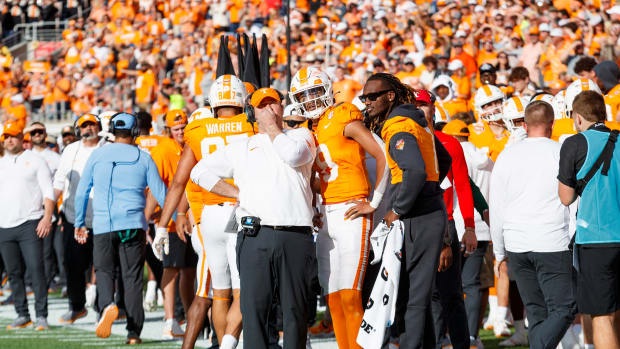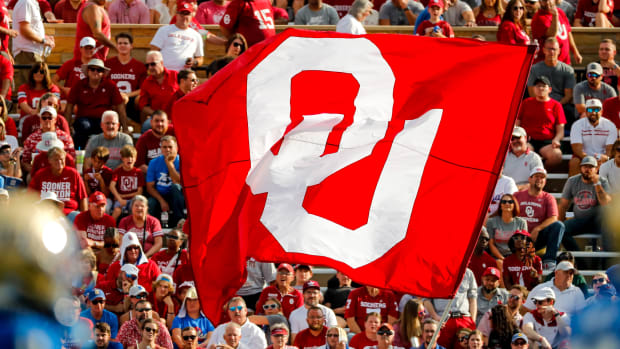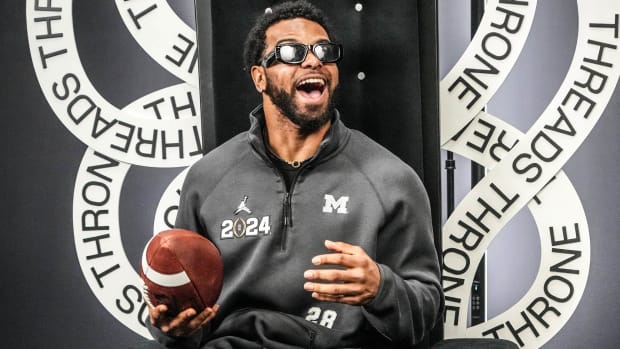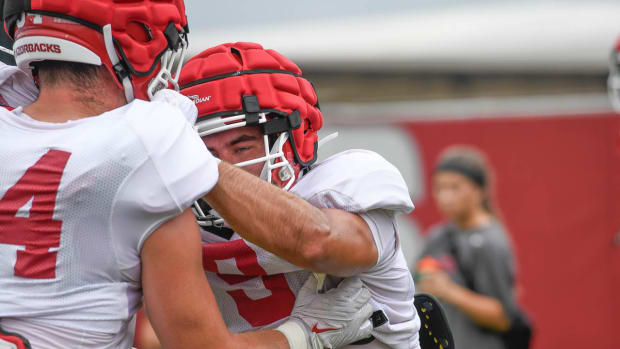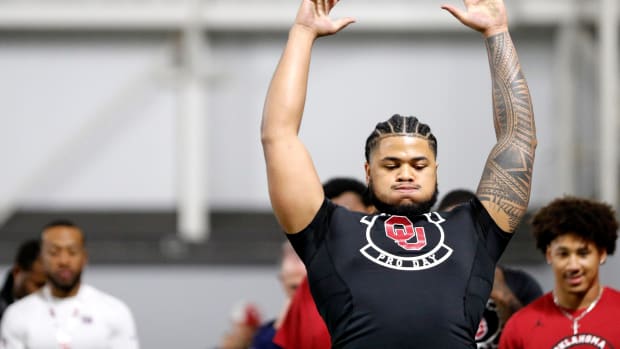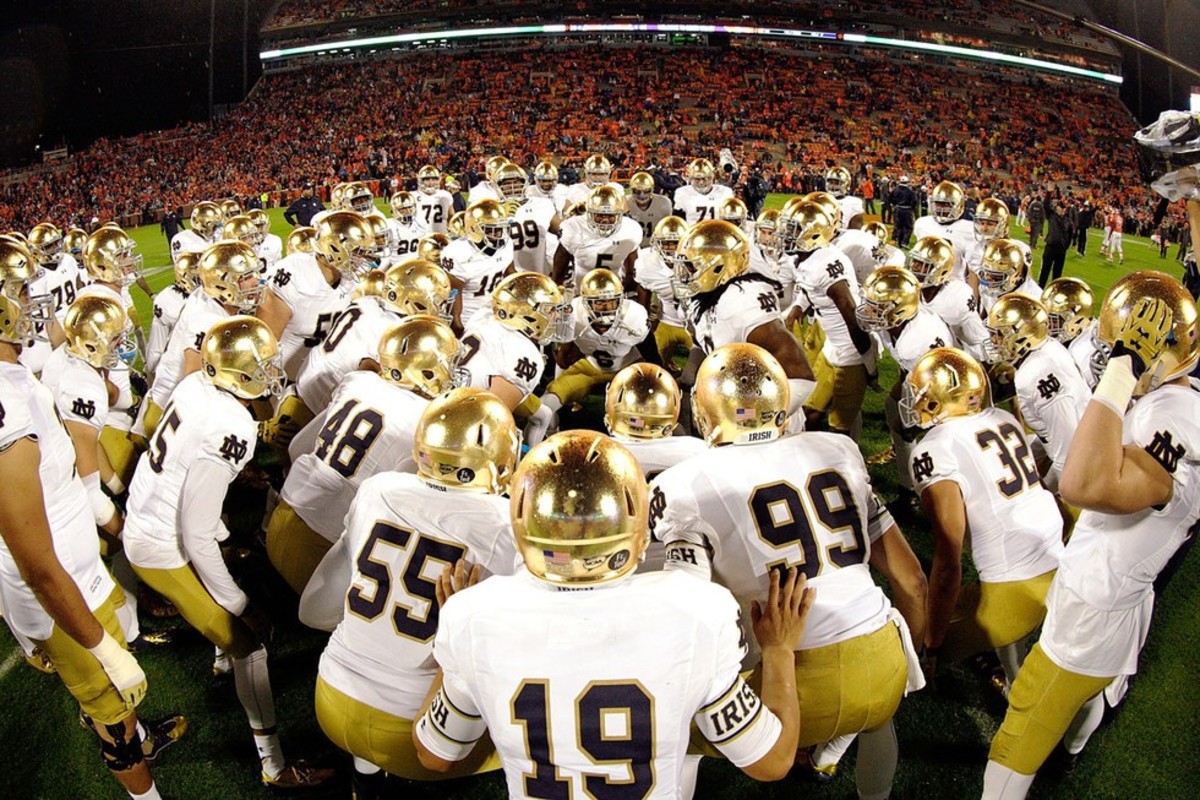
Denying another nosedive: Can this year's Notre Dame football team avoid a repeat late-season collapse?
Entering November, Notre Dame sits at 7–1 and No. 8 in the AP Poll. Its lone loss came on the road to an undefeated ACC opponent when the Fighting Irish fell one play short in the waning seconds. Sound familiar?
It should, because the first two months of Notre Dame's 2015 season have been, in many ways, identical to the first two months of the program's '14 campaign. The record is the same. The ranking is on par. Even the defeat is a near twin. The Irish fell 31–27 to unbeaten Florida State in Tallahassee last October after their would-be go-ahead touchdown was called back for an offensive pass interference penalty. This year, Notre Dame lost to Clemson 24–22 on Oct. 3 in Death Valley when the Tigers denied the Irish on a two-point conversion with seven seconds left.
In both cases, one narrow loss did not doom the Irish's College Football Playoff hopes. Had they finished 11–1 last season, they would have found themselves in a similar position to Baylor and TCU, only with a less damaging defeat and a superior strength of schedule. If Notre Dame goes 11–1 this year, it will have a very strong playoff résumé, especially if Clemson (8–0) continues its run to an ACC title.
However, after quarterback DeShone Kizer's fourth-quarter touchdown pass to receiver Will Fuller against Temple, and following cornerback KeiVarae Russell's interception of P.J. Walker that sealed a 24–20 win over the Owls on Halloween, the 2015 Notre Dame squad would now like the comparisons to last year's team to stop. November was not kind to the Irish of '14. If Notre Dame is to make a run at a national title, it'll need to follow a very different trajectory over the season's final few weeks.
Through eight games last year, Notre Dame had an average scoring margin of 13.8, just a half-point lower than this year's team (14.3). Last year's Irish offense had been slightly less effective to this point (35.4 points per game to 36.5; 6.0 yards per play to 7.1), while last year's Irish defense had been incrementally better (21.6 points allowed per game to 22.2; 5.1 yards allowed per play to 5.4). So, given the way Notre Dame closed out the 2014 regular season—with four straight defeats en route to a disappointing 8–5 finish—why shouldn't a similar flop be expected?
Two key reasons: its response to a wrath of injuries and its quarterback.
*****
Cal Sport Media via AP Images
Notre Dame's injury woes were only beginning at this point last season. Linebacker Joe Schmidt fractured his ankle in a 49–39 win over Navy on Nov. 1. Cornerback Cody Riggs suffered a stress reaction in his foot before the Irish visited Arizona State on Nov. 8. Defensive tackle Sheldon Day sprained his MCL and backup Daniel Cage sprained his knee in a 43–40 overtime loss to Northwestern on Nov. 15, while nose tackle Jarron Jones suffered a Lisfranc injury and safety Drue Tranquill tore his ACL in a 31–28 defeat to Louisville on Nov. 22.
The result was a defense comprised mostly of backups and third-stringers being thrust into the spotlight as the Irish needed to make a playoff push. Notre Dame allowed an average of 5.84 yards per play in its four season-ending losses, and it forced more than one turnover in only its showdown with Northwestern.
This time around, Notre Dame was hit with the injury bug far earlier. Cornerback Shaun Crawford tore his ACL and Jones tore his MCL in fall camp. Tailback Tarean Folston tore his ACL in a season-opening 38–3 victory over Texas. A week later, quarterback Malik Zaire broke his ankle and tight end Durham Smythe tore his MCL in a 34–27 win over Virginia. Tranquill then tore his other ACL in a 30–22 triumph over Georgia Tech on Sept. 19.
Perhaps because of last year's plethora of injuries, the Irish have avoided a collapse on the heels of this fall's onslaught. In fact, while last season's group caved under pressure, the injuries suffered in 2014 may have helped build the necessary depth to survive this year's brutal stretch of bad health.
Look no further than the quarterback leading this year's charge. Kizer, a redshirt freshman, entered spring practice as a third-stringer, behind Zaire and Everett Golson on the depth chart. A transfer and a broken ankle later, and suddenly Kizer was entrusted with rallying the Irish from a late deficit at Virginia, which he did by finding Fuller for a game-winning 39-yard score with 12 seconds remaining.
Since then, Kizer's development has mirrored the evolution of Notre Dame's offense. What was expected to be a run-first attack during the preseason shifted to focus on Zaire after tailback Greg Bryant was declared academically ineligible and Folston went down against Texas. Zaire's injury then pushed the burden on to running back C.J. Prosise, who converted to the position from receiver in the spring. As Saturday's win over Temple demonstrated, though, the Irish can win behind a Kizer-driven approach. The Owls held Prosise to a season-low 25 rushing yards, and Fuller made just five catches for 46 yards. Still, Kizer shined: He racked up 299 passing yards and 143 rushing yards with three total touchdowns.
"We have plenty of athletes that can make plays," Fuller said after last Saturday's game. "That just shows how versatile we are as an offense."
Notre Dame's offense was constructed around Golson last year, a blueprint that worked when his ability trumped his penchant for turnovers. But that fell apart as the interceptions and fumbles mounted, ultimately leading coach Brian Kelly to start Zaire over Golson in the Music City Bowl, a 31–28 win over LSU.
This year's squad boasts a diverse attack that could help it avoid another late-season nosedive. The Irish ran the ball 51 times in a 62–27 victory over UMass on Sept. 26 and relied on Fuller for 50% or more of their receiving yards in wins over Virginia, Georgia Tech and USC. Yet Notre Dame beat Temple with limited production from both players, as Kizer handled the ball for a season-high 53 plays.
"With the tools that we have and the game plans that we put together, [opponents] are going to have to choose something [to try to shut down]," Kizer said.
Improved depth and balance don't guarantee Notre Dame will make a run to 11–1. Major tests remain, starting with Saturday's visit to Pittsburgh and culminating with a season-ending trip to Stanford on Nov. 28. And even if Notre Dame wins out, it doesn't fully control its playoff destiny; an abundance of one-loss or undefeated Power Five champions could keep the Irish out of the four-team field.
Still, for a team conspicuously similar to its 2014 iteration thus far, Notre Dame seems unlikely to repeat the downfall of its forebear. The comparison should end now, the possibility of a bright finish in its stead.

